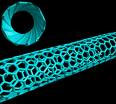 What are carbon nanotubes? How small are they?
What are carbon nanotubes? How small are they?
Carbon nanotubes are small tube-shape structures that are made of graphene sheets. They can be single wall carbon nanotubes (SWNT) or multiwall carbon nanotubes (MWNT). The diameter of SWNT is about 1 nm, while MWNT can have a diameter from a few nm to 100 nm. The figure below showed a part of SWNT.
 There are two major methods that are used to produce carbon nanotubes. (A) Carbon arc method, where graphite rods are evaporated through arc and with transition metal catalysts, carbon vapor condensed and form nanotubes. (B) Chemical vapor deposition (CVD) method, here catalytic nano-particles are deposited first on a substrate. Then the substrate is placed inside a CVD chamber and the temperature is raised to about 800-900 °C. The catalysts will breakdown hydrocarbon gas such as methane (CH4), and carbon dissolved into the catalytic particles and re-grow out as carbon nanotubes.
There are two major methods that are used to produce carbon nanotubes. (A) Carbon arc method, where graphite rods are evaporated through arc and with transition metal catalysts, carbon vapor condensed and form nanotubes. (B) Chemical vapor deposition (CVD) method, here catalytic nano-particles are deposited first on a substrate. Then the substrate is placed inside a CVD chamber and the temperature is raised to about 800-900 °C. The catalysts will breakdown hydrocarbon gas such as methane (CH4), and carbon dissolved into the catalytic particles and re-grow out as carbon nanotubes. Why are you studying these carbon nanotubes?
Carbon nanotubes have some very interesting physical properties such as extreme hardness and excellent thermal conductivity. There are many applications proposed for carbon nanotubes, if we can find ways to manipulate them.
It is difficult to study these nanotubes? Why?
Yes, it is very difficult to study carbon nanotube due to its extremely small size. Electron microscope can be used to observed carbon nanotubes. But methods to manipulate or assemble nanometer size object are still very primitive at this moment.
What are some of the procedures you perform in order to study these carbon nanotubes?
 I prepared my own carbon nanotubes and we used chemical vapor deposition method to produce our carbon nanotubes. We use electron microscopic method to observe them and focused ion beam technique to fabricate nano-devices based on carbon nanotubes. WE then used atomic force microscope to test the physical properties of these carbon nanotube devices.
I prepared my own carbon nanotubes and we used chemical vapor deposition method to produce our carbon nanotubes. We use electron microscopic method to observe them and focused ion beam technique to fabricate nano-devices based on carbon nanotubes. WE then used atomic force microscope to test the physical properties of these carbon nanotube devices.
What would these carbon nanotubes be used for in the near future?
There are many, many applications that have been proposed for carbon nanotubes. For examples, it has potential to be used as electron emitters in a field emission electron microscope. It can be used as a tip for atomic force microscope. It can be used as additives in composite materials to make them stronger and better conducting. It can be used as single electron transistor. Large quantity of carbon nanotubes can be used to fabricate bullet-proof vest.
.
